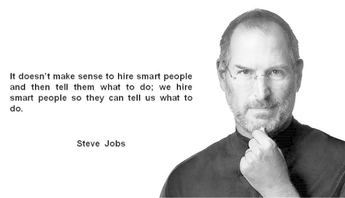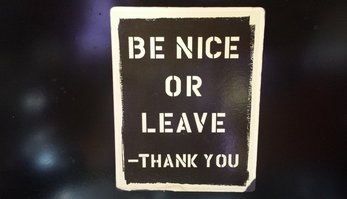 We have all worked for people that we like more than others. But many of us have also worked for people that are simply just short sighted. People that cannot see the forest for the trees, that walk over dollars to save pennies and 20 other clichés’ that I won’t bother to mention. In the world of sales management, these shortsighted views can often get in the way of running a successful organization. I thought I would write them down and look for your ideas on how you have fixed them within your companies. 1. Only travel to visit a potential customer when you are certain you are going to make a sale. This requirement is normally only imposed onto a sales team by a sales manager that has never sold and never traveled. It is like saying a retail sales person should only go and speak to a customer that wants to buy something. How do you know? a. I realize that you should qualify a customer before you go and visit with them in person, but in the world we live in today, if the customer is willing to give you some of their time (and they are the right person), they have an interest. b. Shortsighted Sales Managers do not realize that many good things come out of making presentations. i. You get to practice your presentation ii. You get to learn about the customer iii. The customer gets to learn more about your company iv. You get to encourage them to dream about what your product and service can do for their company. v. You get to find out who they may know that could use your services So there are many advantages of going on an appointment but poor sales managers tend to miss them. 2. You can Manage your way to a successful sales career. I cannot tell you the prevalence of this trait in Shortsighted Sales Managers.They are so concerned about process over product it makes your head spin. I can certainly understand the importance of recording all interactions with the customer. I also understand how poorly sales people do in this area; it is right brain vs. left brain. It is actually a good way to create effective habits for new sales people. But a shortsighted sales manager seems to treat everyone equally, not giving latitude to the winners and more direction to the people struggling for success. Leaders lead and Managers should not be in sales. 3. Thinking that budgets and goals are the same thing. I have never understood paying an employee on a budget, especially a budget set by someone other than the employee. For the first 25 years of my working career I worked for Tandy Corporation/Radio Shack. We never had a budget in the entire time I worked for Radio Shack. We certainly had lots of goals for the company. We had Leaders Club goals, we had the goal for our first Billion Dollar year. We tracked our sales for computers until we got to the first 100,000 (just like McDonalds). But, no one got paid on these goals. We got paid on how much money we made. And that is how all sales people should be paid. Shortsighted Sales Managers use budgets to punish some people and reward others. Budgets that are set by an accountant (no offense to accountants) are the scariest thing to put into a sales organization. Budgets are used by sales organizations that are afraid they are going to pay their sales team too much money. NEVER worry about paying your sales people too much, worry about them not earning enough. 4. Shortsighted Sales Managers never want to face the customer.Shortsighted Sales Managers think their job is to manage the sales force, not to lead the sales force. They only want to go out on the “sure thing” sales calls and then blame the rep if the sale does not happen. Great sales leaders always want to be in front of the toughest sales opportunities. They also take public responsibility for all failures and give praise to their team for all success. 5. Finally, Shortsighted Sales Managers pick favorites. It is so obvious in some organizations that a Sales Manager has picked a favorite. Some times that favorite is because they are the best sales person in the organization, but even then it is shortsighted. While no one can be even handed all of the time, it is important to not appear to have a favorite. It makes all of the disciplines you have tried to put into the organization seem worthless. Why try to get ahead when the boss is going to take care of Mr./Ms. X no matter what happens. One of the best sales managers I ever met always had a favorite. It was the person that had just closed the latest sale. And that favoritism lasted just until the next sale was made. Shortsightedness keeps you from seeing the big picture. It makes you focus on the wrong thing. By letting these wrong ideas get into your sales organizations you are seeding a crop of failure. It may not happen today, but unless you focus on the big picture you are on the wrong road. Steve Jobs had the right idea. Hire smart people and listen to them. Often times 1 person plus 1 more person can yield you the ideas of many people. You might want to get onto a great sales organization by looking at Axcelora and the unique service we provide to the B2B retail/restaurant world. We are constantly looking for people that want to join our group and grow with us.
1 Comment
 The Advantage that E-Commerce Cannot Match There are significant differences between E-commerce and brick and mortar retail. E-commerce is the shiny new object of the retail world. Limitless supply, low overhead, 24-hour access, low rent, low cost of inventory, higher inventory returns, greater Return on Inventory Dollars - these are just a few of the advantages of E-commerce retail. You also have much fewer problems with store employees because you don’t have a store. Yes, you have people sitting in call centers, but they are not the same as retail employees. You typically have much closer supervision for those call center employees. And you have all of the metrics that can be closely monitored. How long were on the phone? Were they able to suggest an additional product? What was their average ticket? There are so many metrics to measure every moment the call center employee is at work. But retail has significant advantages as well. The first advantage is the tactile advantage of retail itself. The customer is in the store so they can feel the merchandise. They can see the subtle color of the shirt, skirt, shoe, or desk that they will have in their home. They can smell the leather of the new purse, jacket or belt that helps to sell your product. And who doesn’t like to go to Costco on Saturday to taste the different foods that are being offered. I am certain that Costco can measure the difference that tastings generate. The next significant advantage is the immediate gratification a consumer gets in taking the merchandise with them. I can save $10 if I buy something from the e-commerce site from Best Buy, but I can have it and enjoy it RIGHT NOW if I buy that same product in the store. And those same employees in the stores that are difficult to manage tend to be a bit smarter and more informed than the call center employees; even if those employees are here in the US. But, you know all of this already. There is nothing new in the two paragraphs above. However, there is something that happens in a retail store that has not been written about and cannot be executed in the E-commerce world and that is Random Acts of Kindness. If you think about the best retailers in the US, there are employees working for those retailers that practice Random Acts of Kindness every day. I have seen employees at DSW hold a baby while the mother is trying on shoes. At Nordstrom’s I have seen employees walk a customer from their department to another department even though they would not make a sale for their efforts, they were just being kind. At Lowes I have asked an employee for a specific product which they did not carry. The employee told me which store I should go and visit to get what I needed. Another Random Act of Kindness. And you simply will not get that in any E-commerce site. If you think back to the original Miracle on 34th Street, you will recall the scene where a child asks Santa (Kris Kringle) for a toy. Macy’s does not have the toy. But Kris tells the child’s mother to go to Gimbal’s, Macy’s arch rival. The word got out that Macy’s was the retailer with a heart. And sales went through the roof. Mr. Macy was thrilled. Random Acts of Kindness are a strategic advantage. But can you teach your team to do be Randomly Kind to customers? I think that is going to be difficult. You can certainly encourage people and recognize people for their Random Acts of Kindness. You can be Randomly Kind to your employees thanking them for their efforts when they don’t expect it. And you should, because Random Acts of Kindness are the biggest advantage that Brick and Mortar has over E-commerce. If a mother has to stop shopping online because she has a crying baby, there is no one from your organization that can hold the baby while she is looking at a blouse. But in a retail store you can certainly try and calm the baby so mom can focus on your merchandise. So if it is difficult to teach Random Acts of Kindness how does a retailer implement this strategic advantage. The answer is easy but the execution is difficult. You hire nice people that simply want to help the 80-year-old customer find the restroom; people that get excited about some else’s happiness; people that want to listen to your story because it makes you happy to tell it. Never in the history of retail have there been so many choices for consumers. And never has it been more difficult to distinguish one retailer's offering from another’s. So the retailer that will win is the one that has made it a priority to find the differentiating factors in retail, like Radom Kind Acts. I once had a boss that told me what an exclusive was. He said an exclusive feature on a product is one that you talk about that your competitor does not. Random Acts of Kindness are features of your offering that your customer will talk about that your competitor’s customers will be envious of. In New Orleans they like to give people a free taste as part of their meal. Something memorable before the meal or something sweet after the meal. It is called Lagniappe (pronounced Lan-yap). At Axcelora we are going to make that same offer to any new clients. When you book 5 appointments or more we will give you one for free to give you a taste of how we work. And we will even make the first one the free one. Our Lagniappe to you. So just contact us at rich.hollander@axcelora.com and we can have a fun conversation.  You have worked hard for the past 12 months. You have made your calls, gone on appointments, and worked to understand your client’s needs. You have followed up, gotten the order, done the paper work and gotten the project or merchandise delivered. You have made your year and it is time for a break. While you are not on vacation officially, your mind has officially left the building. It is Party Time! Now, fast forward to February for all people that just stopped at Party Time. You are scrambling because there is nothing in the pipeline. While your mind left the building, the obligations you have to yourself, your paycheck, and the company certainly have not. While you were relaxing and patting yourself on the back, nothing got done to fill the pipeline. The retailers did not take your calls in January because they were busy trying to figure out what happened in the fourth quarter. What little time they have to take a breath they are using to meet with the very few people that know the quiet dark secret of retail. All of the central unit people have now done all they can do for Christmas. All the ads have been placed, mark downs on under sold items have been taken, and shipments have been made. They are just watching the scores as they come in. With the weather patterns that are moving across the US they may be working on a strategy for winter clothing that is going to be over stocked. But, essentially there are very few meeting that are taking place. And, they are much more likely to answer their phone right now. So, if you want to have a great first quarter, you have to take the next two weeks and be on the phone. Because the next two weeks will separate the winners of 2016 from the losers, it is just that simple. Retail executives are in their offices this week because they don’t want to get in the way of sales in the stores but they want to keep an eye on the business. While they may have meetings planned, they won’t have any time allocated to the stores because, again, they don’t want to be in the way. They will answer their phone because no one else is making the effort to call them. So, pick up the phone and get ahead of your competitors and ask for the appointment. And if you cannot get the appointment you are looking for , call us.  Never have I had such a pleasure than to announce to all of you the publishing of a book by Lew Kornfeld. As you probably know, Lew was with RadioShack for more than 50 years serving as the President and overseeing spectacular growth when Charles Tandy brought the company of 9 stores nearing bankruptcy to the leading Consumer Electronics company in the world with more than 8,000 locations in countries around the world and, at one point, opening more than 600 stores in a year. We have brought together the Presidents Messages and Flyer Side Chats that Lew wrote every month (with just a few exception while he was traveling on business in the orient) for you to get the retail learning of a life time. While this journey is a unique look into the building of the world's premier Consumer Electronics company, it is much more than that. Read it carefully and you can see how the RadioShack culture was built from the inside. The importance of owning your own product and not selling someone else’s. The value of promoting from within an organization instead of demoralizing your own staff. The insight Lew gives us with his writings are something you will want to pass on to your children and your colleagues. So, as Lew would say, “Buy several. I don’t know how we can afford to sell them at this price.” Messages from the President and Flyer Side Chats by Lewis Kornfeld. You can get there by clicking this link http://www.amazon.com/Presidents-Messages-Flyer-Side-Chats/dp/1517070171/ref=sr_1_1?ie=UTF8&qid=1446566243&sr=8-1&keywords=flyer+side+chats All of the profits from the sale of this book will go to support students at the College of Merchandising at UNT, where Lew was kind enough to teach classes on marketing.  In my last post I spoke about how Lew Kornfeld, while he was President of Radio Shack, created two category disrupting products. I have received some positive feedback and questions about how you would go about creating a disruptive product or service. With that in mind, I thought I would share my ideas with you. By the way, you can now get a copy of all of Lew Kornfelds “Messages from the President and Flyer Side Chats” on Amazon.com. This book is a must read for anyone that wants to know the how’s and why’s of the greatest retail electronics company ever created. Many of the principals that Lew and his team used are still very much relevant today. And, as Lew would say, "for only $14.95 I don’t know how they can afford to print it" If you look at Uber and Google, you get a great view of two of the biggest disrupters in today’s business world. While neither of these two companies created their service (advertising in the case of Google and Taxi service in the case of Uber) they both saw inefficient markets that had fallen into the “because that’s how we always did it” trap. In the case of Google, both newspapers and electronic media were run by just a few organizations that had owned their properties for generations. These companies felt like there was an opportunity to better service the consumer by forgetting the rules and just concentrating on the goal of better serving the market they defined. So, let’s go about doing that for your business. Step 1 - Define your goal First define what you are trying to achieve. That is much easier said than done. Too narrow and you are a one trick pony, too broad and you will try and be all things to all people, that has never worked so far. So answer this question and you will be well on your way. What Makes You Unique? In other words, what do you want your customers to be saying about you to their friends once they learn about you? With Google it was their superior search engine. Remember, they did not have the first search engine; they just had the best one. So, by people using that search engine, they could let them see ads. Their other customer (advertisers) would have superior information about the consumer and could reach them more efficiently and in a more targeted way than ever before. Unique and powerful information for their customer to use. So, what makes you unique? Why should the customer choose you to give their hard earned money to? What will they get that will make their life better. Step 2 - Determine your customers activities outside of your store Once you have defined your goal (and if you take it seriously it will take more than just a bit of time; perhaps a couple of days) it is on to your second step. Determine what your customer does with his time or money when not spending them in your store. For instance, when Toys R Us customers are not spending time in their store what else are they doing? I would venture to say they are spending time and money on family vacations, team sports activities, car trips, health insurance, electronic hobbies, religious activities, family meals and many other activities. By understanding the use of time and money by your customer you can now start to understand where there is an opening for you. Step 3 - Look for your opening Have an open discussion as a group. You will find that you feed off each other by working in a group. There should be a time when anyone in the group can say anything. Can you put yourself in the room with the Uber team and hear someone say “let’s just bypass the Taxi authority and lower the costs of operating a Taxi by not having our drivers pay for a shield!” I wonder what we would hear if we were sitting in the room with the folks from Bitcoin. Now there is a discussion. I can hear three people (probably all lawyers) say, "you can’t do that." What would happen to the worlds banking system? In the first part of this session there should be no “you can’t do that!” Remember, you are looking for big unique opportunities. Anything goes, because after this session we are going to move on to step 4. Step 4 - Build your list of real possibilities Work on each of the items you have discussed in Step 3. Let’s say you were in the travel business. You determined your customers like to travel and you would like to help them. They don’t like traveling in groups but like all of the information you can get in group travel. One of the “solves” on the board might be to make individual travel machines with built in geo-based “site” talks. Ask yourselves the following questions: 1- Would the customer like the idea? 2- Is it plausible in today's world? 3- Would the customer pay us a profit for the service 4- How big is the market? And 5- Whose market is going to be disrupted? You may find that for your market you just don’t have a disrupting product. My sense is that if this happens you have not opened your mind to the possibilities. Think about the pet industry. When someone really understood that pets were simply an object for you to share love, they came up with the Pet Rock. You didn’t have to clean up after it, it didn’t get old, and you didn’t have to worry about your Pet Rock biting someone. It was a perfect Pet. Step 5 - The gold is in the details This is where the gold is…the details of the execution. Now that you have determined your disrupting product or service you have to determine how to best bring it to market. When Lew Kornfeld and his team decided to bring a personal computer to the market, there were no significant retail companies offering anything close to it. There was no way to determine how many of these computers would sell. It wasn’t a kit, it was the first fully functional computer ever sold in a national retail chain. Lew came up with an execution plan; he and his team decided that they would order 5,000 units because Radio Shack had 5,000 locations. If the product was a total flop they could use it for their POS system because, at that time they were using wooden drawers. (It was not a flop and it changed the Consumer Electronics business forever.) With both Uber and Google they could have a pretty good guess at how big the market was that they were going to disrupt, and it was huge. At Axcelora, when we were building our model we knew there were more than 10,000 B2B companies that wanted to sell into the retail and restaurant markets. If each of these companies made 10 appointments per year (a low number) than we knew there would be 100,000 appointments made per year at a minimum. We made the assumption that we could gain 2% of that market over time. We then determine the cost of making an appointment (all in) for a B2B company and that influenced our pricing. All of that put together made us realize that we had a real opportunity for a new business. There would be hurdles to jump, of course, just like there is in any new business. But there was reasonable opportunity. So, step 5 is to dive into the details. Look at this like a newspaper reporter and investigate without your emotional hat on. Is there a market? Who are the dominant players I am going to disrupt? How long have they been in the market? Are they willing to kill their current business to defeat you? (In the case of the Taxi business with Uber, would they be willing to devalue the cost of their licenses to work with the city to create their own Uber?) Is their culture bureaucratic or are they still flexible? What will the cost be to you if you fail? Do you have to bet the company or can you step into this gradually? How will your own team take to this new product or service? What will your customers think when you introduce your disruption to the store? Can you sample this on line to get feedback? What happens if you have a hit, can you replenish quickly? Do you have the right people on the team to make this happen? Are they resourceful enough or are they so steeped in tradition that they won’t be able to react to huge problems? There are lots and lots of questions. My STRONG advice here is to write it all down. All problems are more solvable when they are written down. And if you get stuck, just drop me a line, I would be more than happy to help you out. So, to recap: 1. Define your goal 2. Determine your customers activities outside of your store 3. Look for your opening 4. Build your list of real possibilities 5. The gold is in the details, mine for it Think broadly and be open minded. That is the key to this exercise. Don’t worry if it doesn’t happen for you right now, you will get much out of the exercise. Good luck and enjoy the disruption.  There are few feelings more exciting than landing a big sale. If it does not get you pumped up then you are in the wrong business; it's as simple as that. The months and perhaps years of work that goes into a significant sale are an investment of your time, money and most importantly ego. Even if the sale is worth only $250,000 in revenue you most likely have worked between 200 and 400 work hours to land the sale. You have put it all out there for the world and your colleagues to see. If the sale is really significant than you have an opportunity to not win, so when you win it is a really big deal. Your adrenaline is going crazy, you want to jump up on the desk and shout out to the world that you are a winner! And you should. Enjoy the win. Go out to dinner and celebrate with your family and/or colleagues. This is a win. But what do you do next? It has been my observation that you take one of two paths over the next week or two that will determine if you are a professional in your field or if you are just a bag carrying salesperson. Regardless of which path you take, after your celebration the first thing to do is make sure your operations team is fully aware of what you promised the client. Put it all down on paper. If it is not on paper it is just a wish. You have to deliver, so be a professional and get it down on paper immediately. Tell the ops team the who, what, where, when, why and how much for the entire project. Leave nothing out. No detail is too small for this exercise. I know how difficult it is for sales people to write, but take the time to do it and do it completely, you will soon see why this is important. Again, the documentation you write should be done no matter which of the two paths you take. But, taking the right path will lead to much more success than taking the wrong path. The Wrong Path. When I first came to work at Buxton I sat next to the most professional sales person in our organization. He had worked at Xerox and taken their sales course. He knew the course inside and out. He knew when to ask a closing question and what do to if the answer was no. He knew how to deliver a presentation and keep the client involved in the discussion. He was likable and friendly. He had it all going on. Our operations team voted him the salesperson they liked the most. About two months after I started, this sales person closed a big sale; the biggest sale in the history of our company. And here is where the paths split. He stopped working on earning new clients. Just stopped. He had just landed the biggest sale in the history of the company, why should he have to continue to prospect? Wouldn’t the world come to him? Over the next six months our best trained sales person did not make a single sale or outgoing call looking for a new client, not one. In fact, he let his sales pipeline run completely dry. I got to observe this and learn a big lesson. In the retail world, you really do have to wait for customers to come into your store. There are small things you can do every day to stack the odds in your favor that they will come in, but that is one of the few things that you really don’t control. In the B2B world, that is not true. So, while our best person was celebrating his big sale I was making smaller sales; but I never stopped prospecting. At the end of the year my pipeline was full, I had made more sales, and I was his boss. So, what are the 5 things you should do after you make the sale to make sure you are successful? 1. Realize that the lead for your next sale is the customer you just signed. Your customer wants to brag to his friends about the new product or service he/she just bought. Find out who those friends are and ask for an introduction. Do it at the appropriate time, but don’t forget to do it. And now that you made the sale take the client out to lunch or dinner to thank them for their business. If you think about the six degrees of separation, your newest client will know other companies that need your service that are not a conflict. 2. Determine if there is somewhere else in the company might need a part of your service that your newest client did not purchase. If you think about your product or service as a prism, you can turn it around to see different opportunities sitting within a company. Make it a point not to get siloed within a company. You want to be seen as the leader of a team which can answer many questions. 3. Set the tone the client should expect from your company on a go forward basis. The answer is not always yes and right now. You have to be reasonable to both your client and your team that is doing the work. If your client needs a part of the project done quicker, find out why. If it is just curiosity than the client is better off waiting until the entire project is complete. However, if there is a legitimate reason for their request then go back to your ops team and work on a solution. If you set a cooperative tone at the beginning of the project then you are most likely to get cooperation throughout the project which will lead to you delivering a better product. 4. Get permission to send out a news release. This release is important for both you and your client. It tells the world that your client is forward thinking because they hired your company. It also tells the world that both the client and your company are growing and moving forward. And, it will get your name in front of your next client, because they all read about their competitors. Sam Walton used to always tell the world what he was doing, he just executed it better. Sam built the most sophisticated retail distribution system the world had ever seen. He was simply smarter about execution than his competitors. 5. Tell everyone in your company. When you make a sale it is a BIG deal. Without sales there will be no one working at your company, no one. So they should all celebrate with you. Because without the team behind you there would be nothing for you to sell, nothing. Celebrate together. It can be fancy or it can be simple. Bring in a cake, cookies, champagne, ice cream cones, product from your newest account (we actually had some of the new accounts give us merchandise to share with our team, including Ben & Jerry’s and New Balance - we could get chubby and work it off). But do celebrate. That celebration will gain the buy in of the entire company. Instead of only you making the sale, your entire team will feel like they all have made the sale. It is a much better feeling. So, which path are you going to take? Are you going to celebrate and wait for the next sale to come to you or are you going to be the person that enjoys the sale and continues to work on the next sale for your team.  If you have been following the postings I have been making you know that by being Pleasantly Persistent you will have a success rate much higher than other people in our profession. There are also some other benefits to your Pleasantly Persistent efforts. First, if you take the time to study the client each time you make a call, by the time you actually get through to the client you will know much about their business. Secondly, they will respect your tenacity. And thirdly, they will probably have built a positive image about both you and your company. However, there are just some people and companies that you cannot get to respond to your cold calling efforts. This, however, does not lessen your responsibility to get in front of the prospect and make them a client. So, what are you supposed to do to put yourself in the room with the decision makers? 1. Pray. This is the method that most people use if their cold calling efforts don’t work. While the power of prayer is all around us, I could venture to say that this is not the best use of prayer. Prayer should be used for something much more important. Find a different catalyst that will get you doing something, almost anything. While I was in a retail store I would change a display. While I worked in the B2B business I would go to the kitchen and cook something for someone else. Just create activity, you will get better results and your mind will be clear to follow the suggestions below. 2. Work your various networks. See which of your contacts knows someone at your target company. One of our top sales people at Buxton created a process out of this that he worked every day. He would tell people that he never cold called, but he constantly worked on his personal contacts and spent a lot of effort learning and logging who was working with who and their job movements. This master of networking also made many new friends along the way. A year after he began this method he had more than doubled his income. If this is your plan be diligent and don’t try to fool yourself, it never works. 3. Use a cold call service. There are hundreds of them available. You have to determine what image you want to leave with the prospect to determine which service you want to use. Some of them are located here in the US and some are operating out of the country. Some of them use robo-calling techniques and some of them use actors. You will most likely get decent results at the beginning of your program. But, unfortunately, these results are normally short lived. 4. Increase your efforts at Trade Shows. For most companies trade shows are a huge use of resources and the ROI for shows are never measured. The reason for this is pre-show lack of preparation. To make a Trade Show worthwhile, you have to do all of the pre-show preparation.
5. Keep your company in front of the prospect. Make a schedule to send an article about something the prospect should be interested in. Make a rhythm of your efforts. Monday is a bad day to send anything to a prospect as it will get overshadowed by everything else Monday brings. But any other day is just fine. Make the article about growth or problem solving. And make it real, academic articles, while interesting, will not get read by most retail executives. 6. Explore Axcelora. Axcelora is a new service that is being offered to B2B companies that are looking to gain traction in both the retail and restaurant industry. What makes this company unique is the way they go about setting appointments for their clients. Through their network of veteran retail and restaurant executives, Axcelora Partners call their colleagues and make personal introductions and appointments. They take the time to learn enough about your business to be able to set the appointment without trying to make the sale. At this point, Axcelora is the only company that has built this type of network and offers this service  In December of 2000 I made a significant career change. Prior to that time I had worked for only two companies, Radio Shack/Tandy Corporation and Cash America. I had either been responsible for the entire operations of the business unit or I ran store operations. While handling those responsibilities I never had the need to call a company and sell our services; I was the one that companies called upon. At Tandy, we had a non-written rule that all phone calls were returned before you went home that night. Mr. Tandy did it, and so would the rest of us. It was just the right thing to do, and I assumed that everyone followed that practice as well. When I joined Buxton, I quickly learned an important lesson. When I joined I asked Tom Buxton if I could just sell. I had had all the leading and supervising of people that I thought I wanted for the rest of my life. Tom was happy to oblige me. At that time at Buxton we did not have territories, industries, or even companies that we were assigned. We actually had many people calling on the same company, so whoever could get in the door would get the business. So I found one of our databases on retail and quickly picked out retailers within Texas that I wanted to call on. It did not look like anyone else in the company was calling on them so I got to work. I figured this was going to be easy. I would call the proper executive (it was in the database and that had to be up to date :) ) tell them my background, they would meet with me and we would help them with their business. All very logical. But there was one fly in the ointment, one chink in the armor, one bump in the road, one hitch in the giddy up. No one returned my call. No one cared that I actually knew about their business, much less had actually been in one of their stores. They did not know how we could help them profitably grow their business because they NEVER returned my call. NEVER. I did not get it. And, if by chance, I reached an admin (the evil gate keepers), I would get the polite, but none the less fatal, “I will have them call you back.” It never happened. If I did not get to speak with the right person right then, I was not going to get a call back. Did these people not get the memo, didn’t they know they were supposed to call back everyone every day. I will admit that it took me a month or so to stop being angry with these executives. It took me time to realize they lived in a different culture than we did at Tandy and that I was not going to change their culture. However, I still had a responsibility to my friend and family to be successful and if people did not call me back, I had to devise a different tactic to gain access to them. Thus was born the new campaign for access to decision makers. Now, before I tell you this secret that works, I will tell you that, even with the secret spelled out, most of you will not follow it. It will work 80% of the time. I proved it my last year and a half at Buxton by defining 100 companies that we wanted to penetrate with an appointment with a decision maker. Within the next 18 months we were in front of 80 of those decision makers. In the B2B world that is great success. So, it works, it is simple, and I know that the largest part of you will not follow the advice I am about to give you. You won’t follow the advice because you have to park your ego at the curb, and most sales people forget the objective of the exercise is to make sales and can’t park their ego. The secret is Pleasant Persistence. That is it in a nutshell. You have to be Pleasantly Persistent. I cannot tell you how many customers have told me that they took my call because I always left a pleasant message and I always continued to call back, even without getting a call back. So, how can you stay Pleasantly Persistent when you are being ignored? 1. Realize that it your job to get in front of them, it is not their job to have a meeting with you. (Although I think it is their job to meet with you but that is a subject for another discussion). 2. On average it takes 7 calls to get to speak with someone. Most people stop at 2. If you keep going you are going to stand out just because people admire persistence. 3. There is no other option than being pleasant. You can’t call up a prospect and leave a message berating them for their lack of calling you back. You can’t be sarcastic to them; you don’t know them well enough to do that. You can’t threaten them by going up the ladder; that will certainly kill the possibility of a sale even if you do get to see them. So, you might as well be pleasant. 4. Constantly think about how you can help THEIR company with your product or service. I promise you that will come across as you leave your 7th voice mail. 5. Use your CRM tools to politely remind you that it is time to call people. If it is on your To Do List you are more likely to get it done. 6. Rejoice when you do get to talk with someone and let them hear it in your voice. People love to be around a winner and you just won where 90%+ of people would have given up. So, it is a pretty big secret, but don’t worry about getting it stolen, because no one else is going to use it. They just won’t. If you become an advocate of our Pleasantly Persistent approach you will be leading the parade. Now if you don’t want to be Pleasantly Persistent but still need to get in front of decision maker reach out to Axcelora as we can do the job for you.  I think you have all heard of the movie Pollyanna starring Haley Millis (1960). This positive movie about overcoming obstacles that are put in your way by life and circumstances has always had a special place in my heart. You see, although I was a hard core electronics retailer of the 70’s, 80’s, and 90’s, I always thought that things could get better if you could keep a positive attitude. That mind set has served me well in overcoming the challenges that are simply part of life. I have always looked for that silver lining that Pollyanna looked for in her Glad books. When we started discussion about Axcelora one of the things we determined was that we were going to be a Pollyanna Company. We were going to be that great place to work that people often talk about but never quite get there. In my mind that did not necessarily mean a place with lavish perks (after all, we had not sold anything yet) like Nap Rooms (that would be my first perk), massages every Friday, endless snacks, or free travel. It also did not mean that we would have to walk around the office singing Kumbaya and hugging each other. And, oh yes, it did not mean we would have to be politically correct. What it did mean was we were going to completely tolerate and respect each other- gender, preferences, religion and all of the things that get folks excited would be accepted and respected at Axcelora. We would be able to talk politics, religion, world events, even work because we would be building a culture of knowledge and respect. To me these are the principals of Pollyanna. What are they key principals to building this Pollyanna culture? I have thought long and hard about this and have come up with the three things that are working for us right now. 1) Have mutual respect with the people you associate with. I have known the people in the core of our company, the people that have come up with the ideas that are powering Axcelora, for many years. And, we have all come together in this venture/adventure because we respect each other. We come from all different backgrounds but we all have one thing in common; we are accepting and respectful of each other. Our values are all similar even though we may have differing religious and political backgrounds. We have three women and four men on our original team, giving us different points of view on varying subjects. 2) Communicate well. If one of us has done something that is dumb (usually me) the rest of the group is very comfortable expressing their opinion on the subject. This can be written (email, text, note), verbal, or just a look that usually says it all. We communicate well because we respect each other. This has allowed us to eliminate silos. It was established early that everyone could play in each other's sandboxes. We are trying to build a company and build it right. If we see something wrong, we stop and fix it. No one’s feelings get hurt because we respect each other's intelligence, commitment and attitude. 3) Only bring nice people to the party. We established, from the start, that the Axcelora brand is unique and has unique attributes. Since our only assets are the connections our Partners have, we knew we had to have only Partners that are nice. While there are many people that can bring connections to our project, some of them we cannot afford simply because they might think less of our Pollyanna culture. So we have vetted every single new Partner to our group (30 and counting).) We called references to insure our new Partners were nice. We know they are well connected, but we want to insure they are well thought of in their work and will fit in with what we are building. By making this a keystone to our strategy we are confident that Pollyanna will live in our culture. So far, our plan seems to be working. The team we are building is helpful to me and to each other. The effort they have made in fulfilling our customer needs is more than I ever thought would happen. Time will tell how well this Pollyanna idea plays out, but we are off to a good start. If you want the business world to take on this Pollyanna type of culture share our post with your friends.  Without a doubt, Home Office is a significant trend in America that is here to stay. This trend started more than 25 years ago and has consistently grown from year to year. And, while most people that DON’T office from the house think this is nirvana, there is much more to it than that. I have been Officing at home for the last 5 years and thought I would share some tips on how I make it work for me. Here are the 7 things you must to do to successfully Office At Home. 1.Get dressed for work. That’s right, don’t go to work in your PJs, gym shorts, tennis shorts, sweat pants or anything else you would not wear if you were going to an office outside of home. Getting dressed for work changes your attitude of what you are doing in your Home. For the next 8 hours (or whatever period of time you are going to work) you are at work. If you are dressed for work you are much more likely to be productive. 2. Go To Work! While this sounds like an obvious piece of advice many people that office at home don’t…”Go to Work”. You should have a set time that you plan to be at your desk and a set time when you are home. Both getting to the office and leaving the office are important. If you just kind of wander into the office your attitude will be sort of lackadaisical just like it would be if you merely just wandered into your office outside of your home. To successfully Office at Home you MUST get your attitude correct. You must not think of yourself as being at home, but that you are in your place of work. This leads us to rule number 3. 3. While you are in your Home Office be at Work, not at home. When you are in your home office don’t answer the home phone or the front door. Don’t do the little things like taking out the trash, running errands, taking the kids to school, or community events. You are at work. If you were in your other office you wouldn’t do any of these interruptions, don’t do them at your home office. Explain to your family that, while you are at home, you are actually at work. Be tough minded about this because it is important. It will be difficult at first but make the commitment. Your output with jump. 4. Create a work space. Find a space in your house that is just yours. A desk and a chair are preferable, but each home is different. The best place is an office with a door. It should be a place that can be isolated from the rest of the house. You are at work and this space should help you be at work. 5. Set goals. Your day will be much more productive than if you were at the office so you will need to create new more aggressive goals for yourself. You won’t have the distractions of the office environment so you will have more time than ever. If you set reasonable goals for yourself you will see your success rate climb. Make sure you look at your goals daily. Put them up on your office wall so you can keep them handy. 6. Avoid Isolation. One of the biggest traps of working from home is Isolation. Every couple of hours take a bit of time and reach out to a colleague that is also officing at home. Put together a list of people from work that you can take a break with. Don’t talk about work with them. Talk about sports, family, politics, world events, or food. Work to create an office environment with your work partners. Isolation is perhaps the biggest threat to your successful home office. Fight it with the same tenacity you use with all of your other business problems. 7. Communicate. When you office at home you are not in view of the company. You have to make a special effort to let your team know what you are doing. Make a weekly report to your direct supervisor. If you are leading a team of people that work from home make sure to have them communicate their weekly activity and share it with the office. If you or your team has a win, make sure it is communicated to the company. You are not in the office, so if you don’t take the time to do this you will be forgotten by some. If the company is sponsoring an event, make every effort to attend the event. If you cannot attend the event figure out another way to get involved. Send a note to the team in the office to let them know you are thinking of them. Officing from your home gives you incredible flexibility. You don’t have to spend time in your car commuting. You don’t have to disrupt your family and move to a new community for a new job. You can have flexible hours that can give you a better work/life balance. So if you can follow just seven simple suggestions you can increase your chance of success. To increase your chances of sales success give us a call and see how we are helping B2B sales organizations achieve their goals. |
AuthorRich Hollander is a retail expert with over 40 years in the industry. Archives
September 2021
Categories |
© Copyright 2016 Axcelora, LLC.
All rights reserved.
All rights reserved.

 RSS Feed
RSS Feed